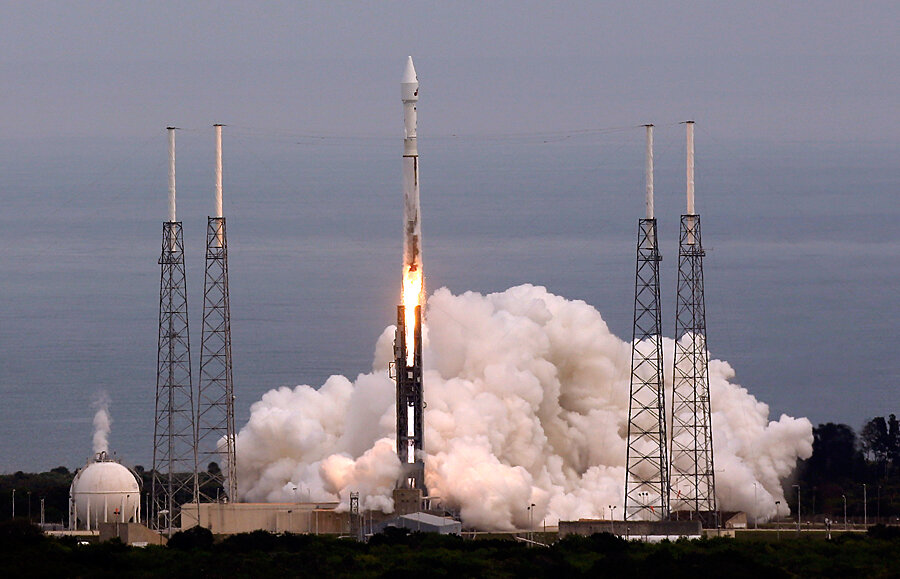What happened to Mars' atmosphere? MAVEN now on way to find out.
Loading...
A healthy MAVEN spacecraft is on its way to Mars.
NASA launched the craft, perched atop an Atlas V rocket, from the Kennedy Space Center at 1:28 p.m. Monday. Some 58 minutes after the picture-perfect launch, the craft separated from the upper-stage booster that put it on course for Mars.
The mission's goal is to study the processes that are stripping Mars of its atmosphere. Early in its history, Mars hosted a thicker atmosphere and warmer climate. Water flowed freely across its surface.
But something happened along the way that cost the planet much of that atmosphere, drying and chilling Mars and rendering the surface uninhabitable.
Scientists have designed MAVEN's instruments to make careful measurements of the planet's upper atmosphere, where the losses take place, and of energetic particles and ultraviolet radiation from the sun. These solar influences are thought to drive the losses.
With at least a year's worth of measurements in hand, scientists then will work backward to reconstruct the atmosphere's vanishing act. In answering questions about changes that have influenced the potential habitability of Mars in its distant past, the researchers hope to shed light on the factors that could alter the potential habitability of planets orbiting other stars.
"We're 14,000 miles from Earth and heading out to the red planet now,” said David Mitchell, MAVEN's project manager at NASA's Goddard Space flight Center in Greenbelt, Md., at a post-launch briefing Monday.
In the run-up to Monday's launch, weather was the main concern. Forecasters had anticipated a 40 percent chance that the launch would have to be scrubbed because of high wind speeds that MAVEN could encounter during its ascent.
Instead, the leading edges of anvil clouds began to overspread the area, said launch director Omar Baez following the launch. These thunderheads popped up along the extended tail of the storm system that moved east through the Great Lakes region Sunday afternoon and evening, spawning tornadoes there as it traveled.
Sensors detected intensified electrical fields in the air near the launch site. This raised concerns that the rocket would trigger lightning strikes as it rose. But the electric fields quickly dissipated, allowing the mission to keep to its schedule.
“The launch was flawless from everything we could tell,” Mr. Baez said.
At 2:21 p.m., MAVEN and its Centaur upper stage parted company to a round of applause from the launch control center. Later, the craft extended its gull-wing solar panels – a significant milestone, since without the panels, the craft has no way to keep its batteries charged.
If all goes well following a course-correction maneuver in early December, the team will activate the science instruments on the spacecraft to make sure they survived the launch, then shut them down for the 10-month cruise to Mars.
Before they do, however, mission scientists hope to take observations of the sun en route. And they'd like to use the craft's Ultraviolet Imaging Spectrograph to observe comet ISON, currently on its way to a close encounter with the sun Nov. 28. The comet will swing within 740,000 miles of the sun's surface before it heads back out into the solar system and into MAVEN's field of view.
“Many of the same gases that are present in Mars' atmosphere are also present in comets,” said Nick Schneider, a planetary scientist at the University of Colorado at Boulder and a member of the MAVEN science team, during a briefing on Sunday. ISON provides “a good opportunity to try out our instrument and do some good science along the way.”
If all goes well, MAVEN is expected to begin orbiting Mars Sept. 22, 2014.
Although the team plans to accomplish its primary science goals during MAVEN's first year at Mars, the craft has enough fuel to allow it to orbit the planet for at least six years. In addition to its science mission, MAVEN is equipped to serve as a radio-relay station for NASA's two operating rovers, Opportunity and Curiosity, as well as for the landers and rovers the US and Europe plan to send to Mars between now and 2020.
Two extant orbiters, NASA's Mars Odyssey and the Mars Reconnaissance Orbiter, are getting a bit long in the tooth, according to Michael Meyer, lead scientist for NASA's Mars Exploration Program at NASA headquarters in Washington. Having an additional orbiter ready for relay duty will help fill gaps left when one or the other orbiter no longer functions.







